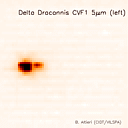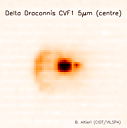First results from the CVF stray-light tests
As mentioned in the ISOCAM Observer's Manual (Chapter 2.1 "Optical design", page 3) it is not possible to have a broad band anti-reflection coating on the detector. Consequently back-reflected light from the detector is a source of stray-light. In order to avoid strong ghost effects the ISOCAM filters are tilted with respect to the optical axis. This of course is not possible for CVFs. Progress is being made in the study of this behaviour and we present here the results of some of our testing to date.
In the CVF stray-light experiment we move a point source over several detector positions. It can be seen that the stray-light pattern is a function of source position on the detector, and of lens and wavelength.
The most dramatic stray-light pattern is found for the 6 arcsec lens, where pixel illumination by scattered light from the primary source is typically below 3% of the corresponding source maximum for most positions of the source on the array. There are a few source locations however, for which the integrated lfux of the ghost contains 15% of the source light. For a source placed at the centre of the field of view the ghost falls back onto the source, so for point source photometry it is not a big problem, though it might affect the detailed appearance of some extended sources.
Click on the following link to see an MPEG movie of the CVF stray-light test in the 6 arcsec lens for a single CVF step position centered ar 5 microns.
For those without access to an MPEG player, a sequence of three images from the movie, with the source moving from left to right, can be seen below (click on any image to retrieve full size version). Alternatively, a non-looping animated gif (or 10 loop animated gif) is also available.



The ISOCAM instrument team designed further dedicated stray-light calibration observations and already special engineering ISO observing time has been granted by the project scientist for ongoing investigations. This should ensure the possibility to quantitatively examine the stray-light phenomenon of CAM04 in the future.
Ralf Siebenmorgen for CIDT.
 [Home Page |
CAM Instrument Page]
[Home Page |
CAM Instrument Page]